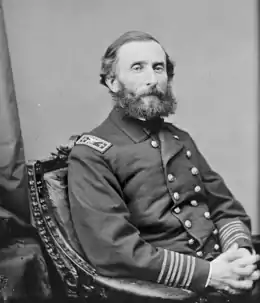James W. King | |
|---|---|
 King during the American Civil War | |
| Chief of the Bureau of Steam Engineering | |
| In office March 23, 1869 – March 14, 1873 | |
| Preceded by | Benjamin Franklin Isherwood |
| Succeeded by | William Willis Wiley Wood |
| Personal details | |
| Born | James Wilson King Unknown date, 1818 Maryland, U.S. |
| Died | June 6, 1905 (aged 86–87) Philadelphia, Pennsylvania, U.S. |
| Military service | |
| Allegiance | |
| Branch | United States Navy |
| Years of service | 1844–1881 |
| Rank | Engineer-in-chief |
| Wars | |
James Wilson King (1818 – June 6, 1905)[1][2] was an American Navy Officer. He served as Chief Engineer of the United States Navy.[1] During his career, he held every position in the Navy to which an engineering officer could be called.[1] Today, he is best known for his 1880 book, The Warships and Navies of the World, which has been called "an important book to establish reliable contemporary information."[3] It was republished by the U.S. Naval Institute in 1982.[4]
Career
King was appointed to the Navy from Maryland as a Third Assistant Engineer on September 2, 1844.[5] During the Mexican–American War, he was attached to the paddle-frigate USS Mississippi and participated in the capture of all but one of the towns on the Mexican coast taken by the Navy.[1] On July 10, 1847,[5] he was promoted to Second Assistant Engineer. King served on all the first steamers that belonged to the U.S. Navy, except the first Fulton.[6]
King was promoted to First Assistant Engineer on September 13, 1849[5] and to Chief Engineer on November 12, 1852.[5] He was appointed Government Inspector of Ocean Mail Steamers at New York in 1853.[6] In 1858, he was appointed Chief Engineer at the New York Navy Yard.[6]
King was Chief Engineer of the North Atlantic Fleet in the early part of the American Civil War.[6] "Subsequently he was the superintendent of the construction of all the armour-clads built west of the Alleghenies, involving an expenditure in the aggregate of seven millions of dollars".[6]
King was promoted to Engineer in Chief on March 15, 1869.[5] In 1869, President Ulysses S. Grant appointed him Chief of the Bureau of Steam Engineering.[1] In this post, King introduced double-expansion engines into the U.S. Navy.[1] He held this post until March 20, 1873.[7][8]
During the mid-1870s, King—as chief engineer of the Navy—made many visits, official and private, to Europe, to collect information relating to shipbuilding, machinery, and other aspects of naval warfare.[3] In 1877, he produced a report to Congress entitled, European Ships of War and Their Armament, Naval Administration and Economy, Marine Constructions and Appliances, Dockyards, etc., etc.[2] King's critical evaluations of naval architecture assumed that Congress might soon fund new designs for a re-equipped American Navy.[3] A second edition was published in 1878.[9] King then produced an expanded version of these reports in his 1880 book, The Warships and Navies of the World.[10]
Retirement and death
King was placed on the retired list on August 26, 1881.[5] He died at his home at 3221 Powelton Avenue, Philadelphia, on June 6, 1905.[1]
Footnotes
- 1 2 3 4 5 6 7 New York Times, Death list of a day; Capt James W King, 7 June 1905.
- 1 2 www.archive.org Report of Chief Engineer J. W. King, United States navy, on European ships of war and their armament, naval administration and economy, marine constructions and appliances, dockyards, etc., etc (1877)
- 1 2 3 www.globalsecurity.org The New Navy.
- ↑ Selected Reference Books: Naval Ships in the Los Angeles Maritime Museum Research Library Collections
- 1 2 3 4 5 6 Naval Historical Center, Officers of the Continental and US Navy and Marine Corps 1775–1900 Archived 2013-09-02 at the Wayback Machine
- 1 2 3 4 5 King, J.W. The Warships and Navies of the World, page v.
- ↑ Navy Department Library Bureau of Steam Engineering
- ↑ Naval Historical Center, Officers of the Continental and US Navy and Marine Corps 1775–1900 US Navy Officers: 1798–1900 - "W" (William W. Wood) Archived 2010-12-05 at the Wayback Machine
- ↑ Browsing Library of Congress Call Numbers : "VA20 .J6" to "VA50 .K8"
- ↑ King, J.W. The Warships and Navies of the World, p. iv.
Bibliography
- Hamersly, L. R., ed. (1870). The records of living officers of the United States Navy and Marine Corps. Philadelphia: J. B. Lippincott & Co. OCLC 422938.